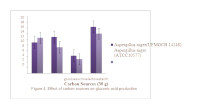Production of gluconic acid from sweet potato peels using naturally occurring fungi by submerged fermentation
Main Article Content
Abstract
The oxidation of glucose produces gluconic acid, a significant organic acid. The aim of this study was to produce gluconic acid from sweet potato peels by submerged fermentation. Isolation and identification of fungi were done using standard microbiological methods. Proximate analysis of substrate and screening of fungal isolates for gluconic acid production was done using standard procedures. Gluconic acid yields were determined using High Performance Liquid Chromatography. A standard gluconic acid producer, Aspergillus niger ATCC 10577, was used as control. A sum of six different fungal species were isolated and identified. They included Aspergillus niger, Aspergillus flavus, Penicillum sp., Cladosporium sp., Rhizopus stolonifer and Aspergillus terreus. Proximate composition of the sweet potato peels showed percentage carbohydrate of 20.81 ± 0.07, percentage moisture of 64.02 ± 0.27. Screening for gluconic acid production showed that Aspergillus niger had the highest zone of clearance and identified as Aspergillus niger UFMGCB 14248. Our data further showed that gluconic acid concentrations (mg/ml) was highest at substrate concentration 50 g/L, carbon source starch, incubation day 7 and pH 6 for both Aspergillus niger UFMGCB 14248 and Aspergillus niger ATCC 10577. The findings showed that the fungal isolates used in this study were good gluconic acid producers.
Downloads
Article Details

This work is licensed under a Creative Commons Attribution-NonCommercial-NoDerivatives 4.0 International License.
References
Akoetey W., Britain, M.M. and Morawicki, R.O. (2017). Potential use of byproducts from cultivation and processing of sweet potatoes. Ciência Rural, Santa Maria, v.47: 05, e20160610
Anastassiadis, A.S., Aivasidis, C., Wandrey, H.J. and Rehm T. (2005) Process optimization of continuous gluconic acid fermentation by isolated yeast-like strains of Aureobasidium pollutants. Biotechnology and Bioengineering, 91(4):494-501
AOAC. (2000). Official Methods of Analysis. 17th Edition., Association of Official Analytical Chemists, Washington, DC., USA.
Ashraf, S.A., Souzy, S., Farag, I.A., Hassan, H.W. and Botros, S. (2014). Production of gluconic acid by using some irradiated microorganisms. Journal of Radiation Research and Applied Sciences, 13, 356-786.
Choi, I. and Zhong, Q. (2020). Gluconic acid as a chelator to improve clarity of skim milk powder dispersions at pH 3.0. Food Chemistry, 344 (7):128639.
El‐Sheikha, A.F. and Ray, R.C. (2010). Potential impacts of bioprocessing of sweet potato: Review. Food Science and Nutrition, 57:455–471.
El Sheikha, A.F. and Ray, R.C. (2022). Bioprocessing of horticultural wastes by solid-state fermentation into value-added/innovative bioproducts: A review. Food Reviews International doi:10.1080/87559129.2021.200416 1
Fawole, M.Q., and Oso, B.A. (2004). Laboratory Manual of microbiology. Spectrum Books, Limited, Ibadan. Pp. 34-35.
Duncan, F.M. (2017). The identification of fungi: An illustrated introduction with keys, glossary and guide to literature. The American Phytopathological Society (APS) 26-70.
Lian, Z., Dai, L., Zhang, R., Liu, Y., Zhou, X. and Xu, Y. (2022). Efficient aerobic fermentation of gluconic acid by high tension oxygen supply strategy with reusable Gluconobacter oxydans HG19 cells. Bioprocess and Biosystems Engineering, 45 (11):1-7.
Ma, Y., Li, B., Zhang, X., Wang, C. and Chen, W. (2022). Production of gluconic acid and its derivatives by microbial fermentation: process improvement based on integrated routes. Frontiers in Bioengineering and Biotechnology,.10:864787.
Makut, M.D., Chioma, D.N., Ike, K.E., Jubril, E.O. and Obuneme S.O. (2021) Production of gluconic acid by fungi species isolated from soil in Keffi, Nigeria. World Journal of Advance Research and Reviews, 11(03),382-390.
Manikandan, A., Muthukumaran, P., Poorni, S., Priya, M., Rajeswari, R., Murugesan, K. and Aravind, J. (2022). Microbial Approaches for Bioconversion of Agro-Industrial Wastes: A Review In: Aravind, J., Kamaraj, M., Karthikeyan, S. (eds) Strategies and Tools for Pollutant Mitigation. Springer, Cham. .151-180.
Mao, Y.M. (2016). Preparation of gluconic acid by oxidation of glucose with hydrogen peroxide. Journal of Food Processing and Preservation. 41 (1). e12742.
Miller, G.L. (1959) Use of dinitrosalicylic acid reagent for determination of reducing sugar. Analytical Chemistry, 31:426- 28.
Nimkar, M.D., Deogade, N.G. and Kawale, M. (2010). Production of alpha-amylase from Bacillus subtilis and Aspergillus niger using different agro waste by solid state fermentation, Asiatic. Journal of Biotechnology.1:23-28.
Rodriguez, H.T., Gonzalez, I., Goire, Y. and Bashan S. (2004) Gluconic acid production and phosphate solubilisation by the plant growth promoting bacterium Azospirillums, Naturwissenschaften, Biotechnology and Bioengineering 552–555.
Šelo, G., Planinić, M., Tišma, M., Tomas, S., Koceva Komlenić, D. and Bucić- Kojić, A. (2021). A Comprehensive Review on Valorization of Agro-Food Industrial Residues by Solid-State Fermentation. Foods. 10 (5):927. doi:10.3390/foods10050927.
Sharma, A. A., Gomashe, A. and Bawane, H. (2015) Gluconic Acid Production by Aspergillus niger from banana must. Journal of Innovation in Sciences 2 (2): 2394
Singh, O.V., Jain, R.K., and Singh, R.P. (2001) Gluconic acid production under varying fermentation conditions by Aspergillus niger. Journal of Chemical Technology and Biotechnology, 78 (23), 208.
Znad, J., Markos, V., and Bales, H. (2004). Production of gluconic acid from glucose by Aspergillus niger: Growth and non-growth conditions, Process Biochemistry. 39,1341–1345


